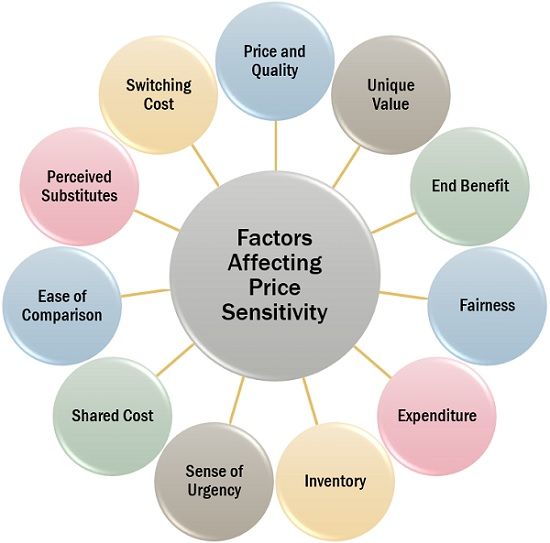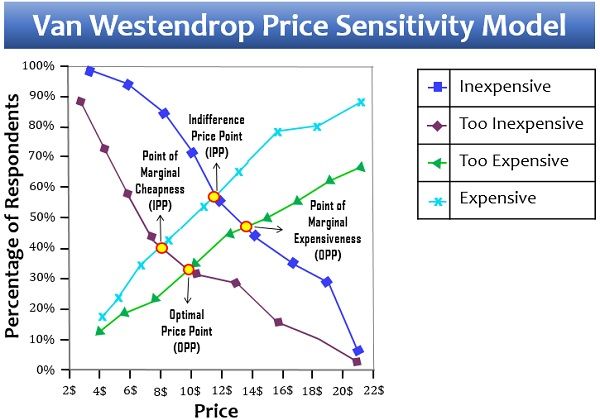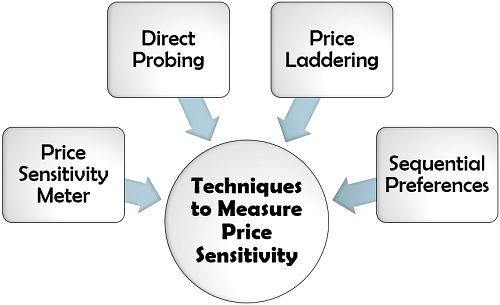Definition: Price sensitivity refers to the degree or extent to which the consumer’s buying behaviour varies with the change in the price of the product or service. In simple terms, it determines the level to which buyers or consumers are conscious about the price of a particular product or service.
It is also termed as price elasticity of demand, which shows the effect of change in the price of goods on the variation in its quantity demanded.
The concept of price sensitivity helps the organizations to fix the right price of the product or service offered for sale. It also enables the business units to be competitive and increase their revenue and sales volume.
Content: Price Sensitivity
Consumer Decision Making Process
To understand consumer behaviour and price sensitivity of the product or service, we must first go through the consumer’s buying process and related decision making:

- Need Recognition: The consumer first identifies the requirement of a product or service.
- Information Search: Next, he/she finds out about the various alternatives available in the market, through advertisements, publicity and previous experiences.
- Deliberation: The buyer then analyzes all the available options on different parameters. Price sensitivity may take place here, since, the consumer can make comparisons and perceive substitutes.
- Purchase: After going through the multiple alternatives, the consumer makes a buying decision by selecting the most suitable product or service.
- Post Purchase: After making the purchase, the buyer examines his/her level of satisfaction. If the consumer feels dissatisfied with the product or service, he/she can ask for its exchange or return (as per the terms and conditions).
Factors Affecting Price Sensitivity
In business organizations, price sensitivity is a crucial factor for ensuring ideal pricing decisions. It is essential to understand the customer’s mindset and behaviour, which influences their price sensitivity.
Following are some of the determinants of price sensitivity of a product or service, considered by the buyer in the deliberation stage of decision-making:

Price and Quality: The buyers are less price-sensitive if the product offered is of superior quality or defines their status quo, such as exclusive or luxury products.
Unique Value: Product differentiation and its unique features, shades the consumer’s price sensitivity towards it. With the unique value products or services, the organization can win over its competitors.
End Benefit: If the product’s utility to the buyer is high, and it fulfils the purchase objective efficiently; then the consumer is less bothered about the product’s price.
Fairness: Price discrimination can lead to a perception of unfair practice among consumers. In such a situation, a slight increase in product price may cause a negative impact, increasing-price sensitivity.
Expenditure: If the product demands a huge expenditure or involves a high cost, the buyer tends to become price sensitive while decision-making.
Inventory: If the buyers (usually industrial buyers) need to maintain stock of the goods, they become more price-conscious.
Sense of Urgency: If there is an immediate need for the product or service, the consumer usually overlooks the price factor. For instance, in the case of emergency medical service, price sensitivity is quite low.
Shared Cost: When the price for a product or service is to be paid by someone else, on behalf of the consumer, he/she may not be price sensitive towards it. Here, the organizations may benefit through price discrimination.
Ease of Comparison: The consumer is more price-sensitive if he/she can easily compare the various options available in the market.
Perceived Substitutes: If the consumers get an equivalent substitute for a particular product or service at a lower price, they become highly price-sensitive towards it.
Switching Cost: When the cost of switching from one company to another is considerably high, the consumer prefers to be less price-conscious and sticks to a single product or service.
Techniques to Measure Price Sensitivity
The consumers’ mindset for a product selection and their price consciousness can be ascertained through the following four methods:
Price Sensitivity Meter
Van Westendrop price sensitivity meter is a technique for determining the consumers’ perception of the price of a specific product or service and its impact over their purchasing behaviour.
To begin with this measure, the researcher needs to ask four price-related questions from the respondents. The response to these questions will ascertain the price points for a particular product or service. These questions are as follows:
- At what price you will find a product to be too expensive to be bought?
- At what price you will feel that the product is expensive and you need to give it a second thought before buying?
- At what price you will find a product to be a bargain or inexpensive and a good value for money?
- At what price you will feel that the product is too inexpensive and consider it of low quality?
Graphical Representation of Price Sensitivity Model
The results obtained through the above questioning can be plotted on a graph as follows:

Thus, we get four crucial price points, which are as follows:
Point of Marginal Expensiveness
PME is the point where the inexpensive line intersects the too expensive line. This intersection shows that while many of the respondents feel that the product is too costly, some of them still believes that it is cheap at the same price point.
Point of Marginal Cheapness
PMC is the point where the premium or expensive line cuts the too inexpensive line. This depicts that at this certain price point when the product is considered to be too cheap by the majority of respondents, some still think it to be pricey.
Optimal Price Point
OPP is the point where the too expensive line crosses the too inexpensive line. This is considered to be the best price point since it has the least number of respondents rejecting the product for being too expensive or excessively cheap.
Indifference Price Point
IPP is the price point where the expensive and inexpensive lines meet. This point states that people are not sure whether to buy the product or not at the given price.
From the above graph, we can determine that the most suitable or acceptable prices lie between the price range from PMC to PME.
The companies price their products across this acceptable price range. However, some of the organizations value their products beyond this range.
Direct Probing
In direct probing technique, the prospective consumer is enquired about the lowest and the highest price, he/she is willing to pay for a specific product or service.
Thus, it provides the organization with a price band having dual ends, one is the lower limit, and the other is the upper limit.
It is the simplest, but a very straightforward way of determining consumer’s price sensitivity. The price sensitivity meter is a variant of this method.
The major drawback of this approach is that it fails to provide proper data for determining the buyer’s acceptability of the product at the price level selected by the maximum number of respondents, along a price curve or band.
Also, it provides only two pricing levels, i.e., minimum and maximum for the respondents, to price the product.
Price Laddering
Here, the respondent is asked to rank purchase intention or willingness to buy a product at a given price, on a scale of 1 to 10.
If a particular product’s price point ranks lower than 8, the organization has to set a lower price point. And again the price laddering is carried out for the new price, up to three price points.
The respondents mostly misinterpret this method as a negotiation process instead of a survey.
Thus, this is not a suitable approach, since the buyers prefer to give the highest rank to the lowest price, which leads to a false market interpretation of price sensitivity.
Sequential Preferences
In this process, the respondents are asked to select their prefered brand when the price of each one is the same. Then by keeping the price of one brand as stable, the value of the other brand is altered, to find out the consumer’s response to this price change.
This approach lacks the information on customer’s relative intensity for preferring a particular brand.
However, this drawback can be overcome by making use of a four-point scale for each brand. This scale may include parameters like strongly preferred, preferred, slightly preferred and least preferred.
Conclusion
When a product’s demand actively reacts to the change in its price, the product is termed as price sensitive. While the ones whose demand is not much affected by the price alterations are called inelastic price products.
Price sensitivity of a product or service can only be estimated by carrying out market research and analysis. However, it may differ from real market conditions or results.

Price says
What a fantastic post! This is very important and useful information. I read a lot of blog posts and this kind of nice information from your blog is very few websites. I love these posts. The post carries very insightful information.